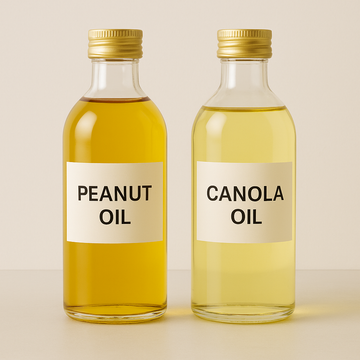In a bustling kitchen, every choice counts — especially when it comes to cooking oil. As a chef juggling health-conscious diners, flavor-forward dishes, and tight budgets, I’ve faced the canola vs. peanut oil decision more times than I can count. What started as a simple question about taste and price quickly turned into a deep dive into heart health, smoke points, environmental impact, and even food allergies.
So, which oil deserves a spot in your kitchen? Let me take you on a quick but thorough journey.
The Flavor Showdown: Nutty vs. Neutral
Peanut oil is the bold guest at your culinary party. It brings a rich, nutty flavor that can transform stir-fries, deep-fried dishes, and Asian cuisine into memorable bites. Meanwhile, canola oil is the quiet hero — subtle, mild, and ideal for letting spices, herbs, or baked ingredients shine without interference.
"I once made fried chicken with both oils side-by-side. The peanut oil version had that craveable toasty depth. But the canola version? It was crisp, clean, and highlighted the marinade more than the fry."
Heat Matters: Smoke Points & Stability
Heat tolerance can make or break your dish. Here's how they compare:
-
Canola oil: Up to 400°F smoke point
-
Peanut oil: Around 450°F smoke point
Both are excellent for high-heat tasks, but canola has a slight edge for flexibility. For deep-frying, either works. But if you need one oil to cover baking, sautéing, AND frying? Canola wins for versatility.
Nutrition: Which Oil Loves Your Heart More?

The American Heart Association recommends oils with low saturated fat and high monounsaturated fat. Here's how they stack up:
-
Canola oil has about 56% less saturated fat than peanut oil.
-
It contains 37% more monounsaturated fat (good for heart health).
-
Canola offers 71.3µg of Vitamin K per tablespoon vs. peanut oil’s 0.7µg.
On the flip side, peanut oil has 13.7% more polyunsaturated fat, which can be beneficial in moderation. But more saturated fat overall gives canola the edge in heart-conscious kitchens.
Cost Battle: Budget-Friendly or Flavor-Packed?
In the commercial kitchen world, cost adds up fast.
-
Canola oil averages 30–40% cheaper than peanut oil by volume.
-
It’s more widely available, making it less vulnerable to supply chain hiccups.
Peanut oil, while pricier, is often used sparingly in flavor-driven recipes. So if you're creating a signature fried dish that hinges on taste, the extra cost may be justified.
Allergies: A Kitchen Risk Worth Considering
Here’s a non-negotiable factor: peanut oil can trigger severe allergic reactions. Even highly refined versions may contain trace proteins. About 1–2% of people in Western countries are allergic to peanuts, making it a risk in shared kitchens.
Canola oil is allergy-safe, making it a go-to for inclusive menu planning.
Environmental Impact: Which Oil Is Greener?
Sustainability is gaining ground with diners and chefs alike.
-
Canola oil can be organic and non-GMO, but its high fertilizer demand can affect water systems.
-
Peanut crops help enrich soil naturally but are often rotated with cotton, which has its own environmental baggage.
Both oils have sustainable options — expeller-pressed and responsibly sourced versions are worth the investment if your brand values eco-conscious choices.
Final Verdict: Which One Wins?

Here’s the bottom line:
-
Choose Canola Oil If:
-
You want a heart-healthy, versatile oil
-
You cater to allergy-sensitive customers
-
You're optimizing for cost and clean flavor
-
-
Choose Peanut Oil If:
-
Flavor is your top priority
-
You’re creating bold, deep-fried, or Asian-inspired dishes
-
You can confidently manage allergen protocols
-
"In my kitchen, I use canola oil 90% of the time. But when I want that extra punch of flavor — especially in fried rice or crispy wings — peanut oil is my secret weapon."
TL;DR: Canola oil is healthier, cheaper, and safer. Peanut oil packs more flavor and heat resilience, but comes at a premium and a higher allergy risk. Know your menu, your audience, and your goals — and stock accordingly.




